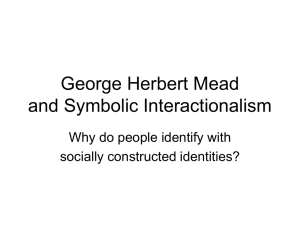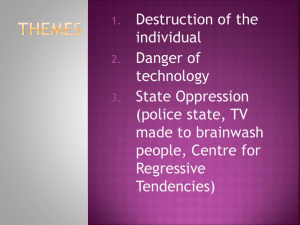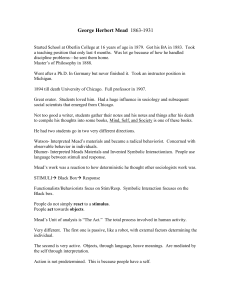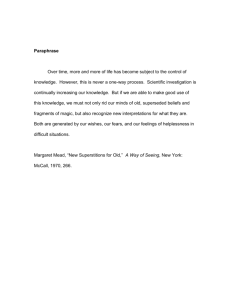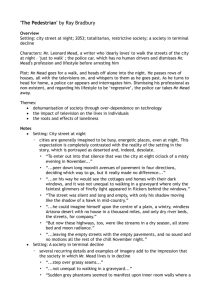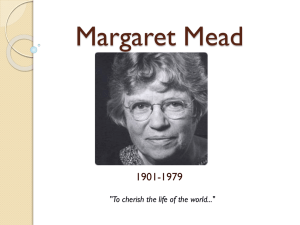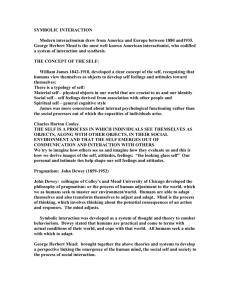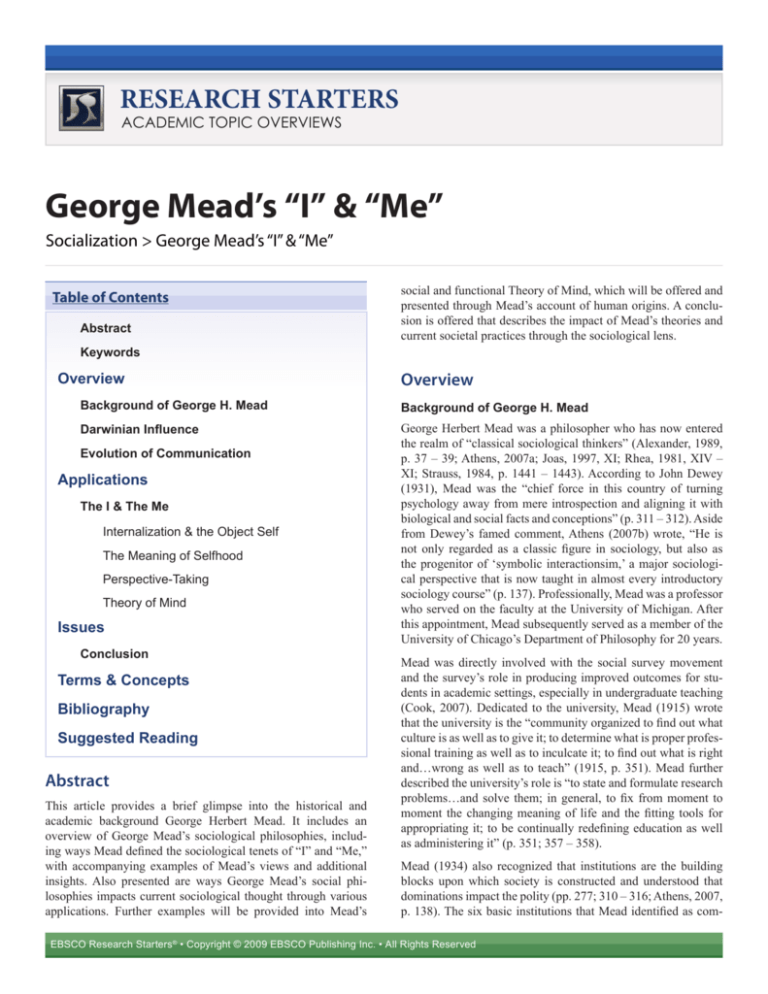
RESEARCH STARTERS
ACADEMIC TOPIC OVERVIEWS
George Mead’s “I” & “Me”
Socialization > George Mead’s “I” & “Me”
Table of Contents
Abstract
social and functional Theory of Mind, which will be offered and
presented through Mead’s account of human origins. A conclusion is offered that describes the impact of Mead’s theories and
current societal practices through the sociological lens.
Keywords
Overview
Overview
Background of George H. Mead
Background of George H. Mead
Darwinian Influence
George Herbert Mead was a philosopher who has now entered
the realm of “classical sociological thinkers” (Alexander, 1989,
p. 37 – 39; Athens, 2007a; Joas, 1997, XI; Rhea, 1981, XIV –
XI; Strauss, 1984, p. 1441 – 1443). According to John Dewey
(1931), Mead was the “chief force in this country of turning
psychology away from mere introspection and aligning it with
biological and social facts and conceptions” (p. 311 – 312). Aside
from Dewey’s famed comment, Athens (2007b) wrote, “He is
not only regarded as a classic figure in sociology, but also as
the progenitor of ‘symbolic interactionsim,’ a major sociological perspective that is now taught in almost every introductory
sociology course” (p. 137). Professionally, Mead was a professor
who served on the faculty at the University of Michigan. After
this appointment, Mead subsequently served as a member of the
University of Chicago’s Department of Philosophy for 20 years.
Evolution of Communication
Applications
The I & The Me
Internalization & the Object Self
The Meaning of Selfhood
Perspective-Taking
Theory of Mind
Issues
Conclusion
Terms & Concepts
Bibliography
Suggested Reading
Abstract
This article provides a brief glimpse into the historical and
academic background George Herbert Mead. It includes an
overview of George Mead’s sociological philosophies, including ways Mead defined the sociological tenets of “I” and “Me,”
with accompanying examples of Mead’s views and additional
insights. Also presented are ways George Mead’s social philosophies impacts current sociological thought through various
applications. Further examples will be provided into Mead’s
Mead was directly involved with the social survey movement
and the survey’s role in producing improved outcomes for students in academic settings, especially in undergraduate teaching
(Cook, 2007). Dedicated to the university, Mead (1915) wrote
that the university is the “community organized to find out what
culture is as well as to give it; to determine what is proper professional training as well as to inculcate it; to find out what is right
and…wrong as well as to teach” (1915, p. 351). Mead further
described the university’s role is “to state and formulate research
problems…and solve them; in general, to fix from moment to
moment the changing meaning of life and the fitting tools for
appropriating it; to be continually redefining education as well
as administering it” (p. 351; 357 – 358).
Mead (1934) also recognized that institutions are the building
blocks upon which society is constructed and understood that
dominations impact the polity (pp. 277; 310 – 316; Athens, 2007,
p. 138). The six basic institutions that Mead identified as com-
EBSCO Research Starters® • Copyright © 2009 EBSCO Publishing Inc. • All Rights Reserved
George Mead’s “I” & “Me”
Essay by Sharon Link, Ph.D.
Darwinian Influence
Keywords
“I”
Internalization
“Me”
Perspective Taking
Pragmatism
Theory of Mind
prising society, included:
Central to Mead’s work was a Neo-Darwinistic perspective
on self and the operation of self within social environments.
G. H. Mead “made the most ambitious and comprehensive
attempt of the pragmatists to set forth a [Darwinian] theory of
mind and behavior” (Thayer, 1973; Mead, 1934, 1936, 1938,
1956, 1964; Joas, 1985). Mead held the view that the social
construct of human beings paralleled Darwin’s view of human
origins; however, Mead’s social psychological story of human
origins emphasized the emergence of the self-consciousness
as a product of “social and physical evolution with particular
emphasis on social factors and the ‘social genesis’ of the mind.”
For improved understanding, Table 1 offers a perspective
parallelism between Darwin’s and Mead’s overview of human
evolution and development.
• Language;
Evolution of Communication
• The family;
According to Mead, in the final stages of the account of human
evolution, humans develop “self consciousness” and “individual
mind.” This increased evolutionary development of consciousness, allowed humans further “refinement, elaboration, and
objectification” enabling humans to not only take common attitudes, but “taking the same attitudes towards oneself that the
community takes” (Burke, 2005, p. 571). The starting point of
Mead’s analysis began with the social experience and a conversation of gestures. At this level, an organism’s action acts as a
catalyst for another organism to respond which in turn becomes
a catalyst for the adjustment of the first organism’s action.
• The economy;
• Religion;
• The polity; and
• Science.
Mead indicated that all institutions are rooted in social action,
and social acts included any activity that required the efforts of
two or more persons to be completed (Mead, 1932, pp. 180 –
182; 1934, pp. 8 – 11). However, he also believed that the hope
and salvation of human society did not rest on these tenets, but
rather on science, because Mead viewed science as having the
ability to provide much needed improvements in the operation of
all of the other institutions (1923, p. 264 – 266; 360 – 364).
The evolutionary breakthrough allowing the development of
“individuality” enables humans to communicate and coordi
nate activities in the roles of “I” and “Me” (Mead, 1956, 1964).
Table 1. Darwin/Mead Origin & Social Psychological
Evolution of Species
Approximation of Years Darwin’s Origin of Species
Mead’s Social Psychological Origins
3.5 million years ago
Australopethicans appear – exhibiting habitual
bipedal locomotion and regular tool use.
Life forms are driven to survive (at least) and flourish (at
best) under changing and life threatening conditions.
2.1 million years ago
Homo genus appears – are able to “manufacture” tools.
The evolution of sentience and sociality in group life forms
permits reactions to excitations in favor of the playing out
of complex, organized habits.
1.5 million years ago
Homo erectus appears with upright posture.
Complex life forms are able to participate in shared
Homo erecus is able to control fire and migrate activities and mutual cooperation – giving rise to commuextensively throughout Africa, Europe, and Asia. nication through signs, signaling, and gestures.
500,000 years ago
Archaic Homo Sapiens (Homo heidelbergensis)
show dramatic increase in brain size and cognitive advances.
Taking attitudes of others – this interaction allows perspective-taking and perspective switching.
130,000 years ago
Anatomically modern Homo sapiens appear in
Africa with modern brain size
Taking attitudes of group – provides conditions for reflexive social stimulation and response.
50,000 years ago
Behaviorally modern Homo sapiens evolve pos- Draw on Organized Attitudes through the use of significant
sessing technologically and cultural innovation. symbols
11,000 years ago
Humans change from hunter-gatherers to agricultural foragers, exhibiting ethnic differences.
Reflexive Discourse emerges allowing humans to anticipate responses of others.
Adapted from Burke T. (2005). The role of abstract reference in Mead’s account of human origins, Transactions of the Charles S.
Pierce Society, XLI(3), 568 – 571.
EBSCO Research Starters ® • Copyright © 2009 EBSCO Publishing Inc. • All Rights Reserved
Page 2
George Mead’s “I” & “Me”
Tomesello (1995, 1999) reported that these evolutionary processes invites individuals in a species to engage in new activities
while Table 1. Darwin/Mead Origin & Social Psychological
Evolution of Species providing the stabilizing capacity to engage
in these new activities, which could arguably improve human
interaction in society. These evolved abilities in combination
with Mead’s interest in perspective taking and societal emphasis
ultimately supported Mead in his research regarding the “I” and
“Me” as phases of human evolution, which was only possible
when humans passed from the conversation of the gestures to the
internalization of the other (Geniusas, 2006, p. 247).
Applications
The I & The Me
Mead’s interest in human consciousness and the private and personal aspects of consciousness led him to study the biological
nature of an organism and the social nature of self, thereby equipping him with the resources to account for the “development of
mind and self-consciousness” (Geniusas, 2006, p. 243). “I” and
“Me” can best be identified as “phases of the self,” which was
Mead’s attempt at narrowing his philosophies to the discipline of
psychology (Cook, 2007, p. 170). “The two are separated in the
process, but they belong together in the sense of being parts of a
whole” (Mead, 1962, p. 178).
Internalization & the Object Self
The internalization process can best be recognized as “me” or
the “self we are aware of” and the way in which humans internalize an organized set of attitudes of others. In contrast, the “I” of
the self is the response to the attitudes that the organism offers.
For further clarity, the “I” phase is the side of freedom of initiative, while the “me” phase refers to “attitudes, roles, meanings,
pressure, and values of others which are organized into one’s
self through the agency of role-taking” (Geniusas, 2006, p. 247).
The “I” phase refers to the part of the self which can be identified with impulse, freedom, and creativity; everything which is
unique, idiosyncratic, and uncertain. Essentially, Mead (1962)
wrote that the “I” and “me” revealed the distinguishing feature
of the self, which was that as self is to be in object to oneself.”
Mead posed the question, “How can an individual get outside
of himself (experientially) in such a way as to become an object
to himself? This is the essential psychological problem of selfhood” (p. 138). Mead further wrote, “The individual is not a self
in the reflexive sense unless he is an object to himself” (p. 142).
Lastly, Mead stated, “The individual enters as such into his own
experience only as an object, not as a subject” (p. 225).
Important to the understanding of “I” and “me” is that the model
provides an understanding of the dual nature of our own selfhood while also providing humans with a perceptive of how “the
two poles of our own selves are given in experience.” However,
in most cases, Mead “identifies the ‘me’ with the ‘object self’ of
experience (Geniusas, 2006, p. 248).
Essay by Sharon Link, Ph.D.
Mead distinguishes “I” as a response that originates from our
bodily organisms and claims that this response is “spontaneous and subjective” (Geniusas, 2006, p. 249). He stated, “If one
answered to a social situation immediately without reflection,
there would be no personality…any more that there is personality in the nature of the dog or the horse” (1962, p. 182). He
further suggested that “an inner response to what we may be
doing, saying, or thinking” supplements “a large part of our conscious experience, indeed all that we call self-consciousness”
(1964, p. 145). In this way of thinking, meaning arises only
through communication. Meaning is implicit wherever there
is present, “a triadic relation of a gesture of one individual, a
response to that gesture by a second individual, and completion
of the given social act initiated by the gesture of the first individual” (Mead, 1934, p. 81). Mead further wrote that animals
live in a world of events; man lives in a world of common meanings – and meaning for Mead is socially generated and sustained
(1938, p. ix – x).
The Meaning of Selfhood
The fundamental nature of “I” and “me” seems to be the transcendental aspect of selfhood. Mead does not openly speak of
the transcendental, but arguably metaphysical resonances can
be evidenced in his philosophies of the “I” and “me” relationship: “I do not want to discuss metaphysical problems, but
I want to insist that the self has a sort of structure that arises
in social conduct that is entirely distinguishable from this socalled subjective experience” (1962, p. 166). His methodology
immediately places the self in a reciprocal structure with otherness, and repeatedly insists that self can itself only as a “me,”
and never as an “I.” Moreover, to overcome the shortcomings
of the metaphysical notions of the subject amounts to “bracketing metaphysical questions and in their stead accounting for the
self in terms of behavior” (Geniasas, 2006, p 259). Indeed, the
self must safeguard the self as subjectivity; one needs to “sacrifice the possibility of its immediate givenness to consciousness:
the “I” cannot be known simply because the “I” is a subject,
and not an object of experience” (p. 260). According to Mead,
each self is not only a “me,” but also an “I” because every self
has a unique and peculiar individuality, which manifests itself in
free and creative responses back against the society. “There is a
demand, a constant demand, to realize one’s self” (Mead, 1962,
p. 205). From a sociological perspective, the self is a model of
social control. It is also the primary source of social control
whose origin “lies in the experience of a rudimentary demand
to which one is obliged to respond – a debt, which one must,
although never can, fully repay” (Geniusas, 2006, p. 263).
Perspective-Taking
The most important aspect of Mead’s theory is his notion of the
social role. A key system is the formation of mind in the individual’s capacity to mentally adopt the standpoint of others. This
notion of interpersonal perspective taking and intrapersonal perspective taking is the stronghold for Mead’s theories and plays a
vital role in the development of language, and is present in other
EBSCO Research Starters ® • Copyright © 2009 EBSCO Publishing Inc. • All Rights Reserved
Page 3
George Mead’s “I” & “Me”
areas of conduct as well. Mead (1934) notes that children display
this kind of interaction when they adopt parental attitudes, such
as when playing with dolls, and these attitudes are both cognitive
and emotional (p. 365 – 366). This attitude is the same as the
“generalized other,” which attitude the “member must take if he
is to act in a socially coordinated way (Mead, 1934, pp. 164 –
222). Most importantly in terms of sociology and science, Mead
did not diverge from the dominant views now held in sociology
(Fallding, 2001, p. 735).
Mead was a colleague and friend of John Dewey, who was considered the father of education. Together they worked at the
universities of Michigan and Chicago in the 1890s and early
1900s. Their sociological constructs were pivotal in a philosophical movement known as pragmatism. The pragmatists
stressed the experimental and purposive nature of cognition.
Mead’s work was defined as “not psychology.” Mead’s social
psychology stands juxtaposed with orthodox cognitive social
psychology, meaning that the individual is not a social atom, but
is instead a “product of society.” The person in this sense is a
social construction.
Theory of Mind
In this sense, there is no “essential core or self to the person,”
and each person could have been constructed differently. Once
constructed by society, individuals themselves then shape societies. Berger and Luckmann (1967) described this relationship
as a dialectic operation. The cornerstone of this philosophy is
that “people are not born with what we think of as a self, but
develop it in their interaction with others.” The unit of analysis
in this interaction is the social act. When humans begin the process of developing self-consciousness and are able to take on
perspectives of others, this role taking is known as “theory of
mind” (Butt, 2008, p. 105 – 106). Mead (1982) labeled this ability “emergent property.” He wrote:
We are conscious of our attitudes because they are
responsible for the changes in conduct of other individuals. A man’s reaction towards weather conditions
has no influence upon the weather itself. It is important
for the success of his conduct that he should be conscious not of his own attitudes, of his own habits of
response, but of the signs of rain or fair weather which
a consciousness of one’s own attitudes helps toward the
control of the conduct of others (p. 348).
After reading and analyzing this text, we may conclude that
George Mead’s central influence lies in two areas. First, Mead’s
work is central to the theoretical discipline of sociology. This sociological construct influences both the disciplines of philosophy
and education. These concepts are formative in structure of how
human organisms come to know themselves and their interactions.
Undergraduate students studying sociology will become familiar
with G. H. Mead and his beliefs regarding human development
and human interactions. Enthusiastic sociology students can consider applying Mead’s work as a primary underpinning for other
disciplines, and as a way of viewing societal constructs.
Essay by Sharon Link, Ph.D.
Issues
One of the central issues regarding Mead’s work could relate
back to the limitations of the theoretical construct upon which
Mead based his work. Puddephatt (2005) wrote: “Mead’s
contributions have a great deal to offer the understanding of technological development, and the use of the technology by human
communities” (p. 358). In further analysis, Puddephat indicated
that Mead’s contributions to math and science were overlooked,
because of the “intellectual divide of the Atlantic” (p. 358). Most
scientific contributions to math and science originated in Europe,
and Mead was considered an American pragmatist. A central
issue attributed to this philosophy is that Mead seemed to tie most
of his viewpoints to perspective taking through the “generative
dialogue with the material world.” By engaging in interaction,
humans could “take the role” of objects, “objectify their own
actions, and generate meaning through this ongoing dialectical
relationship” (p. 372). This opportunity seems to invite a solid
theoretical foundation for studying the development of technology. Sociologists could utilize these theories as underpinnings
into further study regarding technology, the meaning of technology, and human interaction with technology.
However, the main issue is that Mead in his day, time, and era
seemed to omit key implications, because of a lack of communication with other scholars located on other continents (which
ironically would have been aided through more advanced technology). It is up to young scholars and students of cultural and
societal constructs to further elaborate and build upon Mead’s
work: “If Mead’s work is to be saved from becoming irrelevant
in sociology and is to remain an invaluable intellectual resource
for this field in the 21st century, then now is the crucial time to
revise his theory” (Denzin, 1996, pp. 63 – 64, 74).
Conclusion
G. H. Mead (1862 – 1931) “made the most ambitious and comprehensive attempt of the pragmatists to set forth a [Darwinian]
theory of mind and behavior” (Thayer, 1973; also Mead, 1934,
1936, 1938, 1956, 1964; Joas, 1985). Mead proposes that humans
construe the distinction between subjective and objective elements
of experience as a functional, rather metaphysical experience
(Mead, 1964). Famous for many theories, one of Mead’s most
well known theories and terms were identified as “I” and “me”
and the principles of self. In speaking of these terms, Mead sought
to make the point that the human individual or self could enter in
two distinguishable senses. The “me” in this case functioned as an
object, which holds a mediating role within an ongoing process of
experience or action and the “I” functioning as the “self in the disintegration and reconstruction of its universe, the self functioning,
the point of immediacy that must exist within a mediate process”
(Mead, 1964). For sociology students, or any academician interested in further understanding Mead’s contribution to sociology,
philosophy, psychology, and education, further research should
be done to facilitate deeper and more comprehensive learning,
because many researchers provide a solid argument for Mead’s
historical and lasting impact.
EBSCO Research Starters ® • Copyright © 2009 EBSCO Publishing Inc. • All Rights Reserved
Page 4
George Mead’s “I” & “Me”
Terms & Concepts
“I”: “I” is a subject, and not an object of experience. The “I”
phase refers to the part of the self which can be identified with
impulse, freedom, and creativity; everything which is unique,
idiosyncratic, and uncertain.
Internalization: The internalization process can best be recognized as “me” or the “self we are aware of” and the way in
which humans internalize, or adopt a set of beliefs, which are an
organized set of attitudes of others.
“Me”: “Me” can be identified with the ‘object self’ of experience. It can also be described as the “self we are aware of.”
Perspective Taking: A central issue attributed to this philosophy is that Mead seemed to tie most of his viewpoints to
perspective taking through the “generative dialogue with the
material world.” By engaging in interaction, humans could “take
the role” of objects, “objectify their own actions, and generate
meaning through this ongoing dialectical relationship.
Theory of Mind: When humans begin the process of developing self-consciousness and are able to take on perspectives of
others, this role taking is known as “theory of mind”
Bibliography
Essay by Sharon Link, Ph.D.
Denzin, N. (1996). Post-pragmatism. Social Interaction, 19,
61 – 75.
Dewey, J. (1931). George Herbert Mead. Journal of
Philosophy, 12, 309 – 330.
Geniusas, S. (2006). Is the self of social behaviorism capable
of auto-affection? Mead and Marion on the “I” and the
“me.” Transactions of the Charles S. Peirce Society, 42(2),
242 – 265. Retrieved June 25, 2008 from EBSCO Online
DatabaseAcademic Search Premier: http://search.ebscohost.com/login.aspx?direct=true&db=aph&AN=22234631
&site=ehost-live
Fallding, H. (1982). G. H. Mead’s orthodoxy. Social Forces,
60(3), 723 – 737. Retrieved June 25, 2008 from EBSCO
Online DatabaseAcademic Search Complete: http://
search.ebscohost.com/login.aspx?direct=true&db=a9h&A
N=5280353&site=ehost-live
Joas, H. [1985] (1997). G. H. Mead: A contemporary re-examination of his thought. Cambridge: MIT Press.
Mead, G. H. (1915/1964). Natural rights and the theory of
the political institution. In A. Reck, ed. Mead: Selected
Writings, 150 – 170. Indianapolis: Bobbs-Merrill.
Alexandra, J. (1989). Structure and meaning: Rethinking classical sociology. New York: Columbia University Press.
Mead, G. H. (1923/1964). Scientific method and the moral
sciences. In A. Reck, ed. Mead: Selected Writings, 150 –
170. Indianapolis: Bobbs-Merrill.
Athens, L. (2007a). Mead, G. H. In G. Ritzer, ed. The
Blackwell Encyclopedia of Sociology. 2861 – 2864.
Malden, MA: Blackwell.
Mead, G. H. (1932). The philosophy of the present. A. Murphy,
ed. La Salle: Open Court.
Athens, L. (2007b). Radical interactionism: Going beyond
Mead. Journal for the Theory of Social Behavior, 37(2),
137 – 165. Retrieved June 25, 2008 from EBSCO online
database, Academic Search Premier on. http://search.
ebscohost.com/login.aspx?direct=true&db=aph&AN=252
44839&site=ehost-live
Berger, P. L. & Luckmann, T. (1967). The social construction
of reality. New York: Doubleday.
Burke, T. (2005). The role of abstract reference in Mead’s
account of human origins. Transactions of the Charles
S. Peirce Society, XLI(3), 567 – 601. Retrieved June 25,
2008 from EBSCO Online DatabaseAcademic Search
Premier.http://search.ebscohost.com/login.aspx?direct=tru
e&db=aph&AN=19365440&site=ehost-live
Butt, T. (2008). The emergence of self in relationship.
Existential Analysis, 19(1), 102 – 112. Retrieved June 25,
2008 from EBSCO Online Database Academic Search
Premier: http://search.ebscohost.com/login.aspx?direct=tr
ue&db=aph&AN=31211115&site=ehost-live
Mead, G. H. (1934). Mind, self & society, edited and introduced by C. Morris. Chicago: University of Chicago
Press.
Mead, G. H. (1936). Movements of thought in the 19th century.
Chicago, IL: University of Chicago Press.
Mead, G. H. (1938). Philosophy of the act. Chicago, IL:
University of Chicago Press.
Mead, G. H. (1956). On social psychology. A. Strauss, ed.
Chicago: The University of Chicago Press.
Mead, G. H. (1962). Mind, self, & society from the standpoint
of a social behaviorist, ed. C. W. Morris. Chicago: The
University of Chicago Press.
Mead, G. H. (1982). Social consciousness and the consciousness of meaning. In Thayer, H. (ed). Pragmatism: The
Classic Writings. 341 – 350. Indianapolis: Hackett.
Puddephatt, A. J. (2005). Mead has never been modern:
Using Meadian theory to extend the constructionist study
EBSCO Research Starters ® • Copyright © 2009 EBSCO Publishing Inc. • All Rights Reserved
Page 5
George Mead’s “I” & “Me”
of technology. Social Epistemology, 19(4), 357 – 380.
Retrieved June 25, 2008 from EBSCO Online Database
Academic Search Premier: http://search.ebscohost.com/
login.aspx?direct=true&db=aph&AN=18851911&site=eh
ost-live
Rhea, B. (1981). Introduction. In B. Rhea, ed. The Future
of the Sociological Classics. ix – xi. London: Allen &
Unwin.
Strauss, A. (1984). Review of David Miller’s the individual
and the social self: Unpublished writing of George
Herbert Mead. American Journal of Sociology, 89, 1441
– 1442.
Tomasello, M. (1995). Language is not an instinct. Cognitive
Development. 10,131-156.
Tomasello, M. (1999) Cultural Origins of Human Cognition.
Cambridge, MA: Harvard University Press.
Essay by Sharon Link, Ph.D.
Thayer, H. S. (1973). Meaning and action: A study of
American pragmatism. Indianapolis: Bobbs – Merrill
Company. [Shortened version of Thayer 1968].
Suggested Reading
Fuller, S. (2002). Social epistemology. 2nd ed. Bloomington,
IN: Indiana University Press.
Mead, G. H. (2001). Essays in social psychology, edited by M.
Deegan. New Brunswick: Transaction.
Sismondo, S. (1996). Science without myth: On construction,
reality, and social knowledge. New York: SUNY Press.
Sokal, A. & Bricmont, J. (1998). Fashionable nonsense:
Postmodern intellectuals’ abuse of science. New York:
Picador.
Stringer, C. & McKie, R. (1996). African Exodus: The Origins
of Modern Humanity. London: Jonathan Cape and New
York: Henry Holt and Company.
Essay by Sharon Link, Ph.D.
Dr. Sharon Link is an educator, presenter, and mother of a child with autism. She has worked extensively in public education and
has researched education and its relationship to autism disorders and other disabilities for the last ten years. Dr. Link currently is the
Executive Director for Autism Disorders Leadership Center, a non-profit research center and is co-founder of Asperger Interventions &
Support, Inc. a professional development center. Both organizations are education and research centers seeking to improve education by
creating a system of diversity and inclusion in America’s schools. To learn more, visit: Asperger Help at http://aspergerhelp.net.
EBSCO Research Starters ® • Copyright © 2009 EBSCO Publishing Inc. • All Rights Reserved
Page 6

